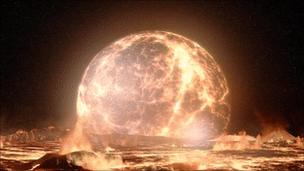Why the Moon is getting further away from Earth
- Published

The Moon is not only beautiful, it is vital to our ecosystems and wildlife
The speed at which the Moon is moving away from Earth could affect life on the planet, but this could take billions of years to happen, writes space scientist Dr Maggie Aderin-Pocock.
It's easy to take the Moon for granted, even on a clear night when it can light up the sky. It really feels as if it has always been there just as it is now, throughout history. But that's not strictly true.
It is thought that the Moon was formed when a proto-planet about the size of Mars collided with the early Earth around 4.5bn years ago. The debris left over from impact coalesced to form the Moon. Computer simulations of such an impact are consistent with the Earth Moon system we see in the 21st Century.
The simulations also imply that at the time of its formation, the Moon sat much closer to the Earth - a mere 22,500km (14,000 miles) away, compared with the quarter of a million miles (402,336 km) between the Earth and the Moon today.

The Moon is believed to have formed after a massive collision between the Earth and an asteroid
The Moon continues to spin away from the Earth, at the rate of 3.78cm (1.48in) per year, at about the same speed at which our fingernails grow.
Without the Moon, the Earth could slow down enough to become unstable, but this would take billions of years and it may never happen at all.
The migration of the Moon away from the Earth is mainly due to the action of the Earth's tides.
The Moon is kept in orbit by the gravitational force that the Earth exerts on it, but the Moon also exerts a gravitational force on our planet and this causes the movement of the Earth's oceans to form a tidal bulge.
Due to the rotation of the Earth, this tidal bulge actually sits slightly ahead of the Moon. Some of the energy of the spinning Earth gets transferred to the tidal bulge via friction.
This drives the bulge forward, keeping it ahead of the Moon. The tidal bulge feeds a small amount of energy into the Moon, pushing it into a higher orbit like the faster, outside lanes of a test track.
This phenomenon is similar to the experience one feels on a children's roundabout. The faster the roundabout spins the stronger the feeling of being slung outwards.
But the energy gained as the Moon is pushed higher is balanced by a reduction in the energy of its motion - so an acceleration provided by the Earth's tides is actually slowing the Moon down.
While 3.78cm may not seem like much, this small difference over a long enough period of time could affect life on Earth, making the planet slow down.
On early Earth, when the Moon was newly formed, days were five hours long, but with the Moon's braking effect operating on the Earth for the last 4.5bn years, days have slowed down to the 24 hours that we are familiar with now, and they will continue to slow down in the future.
We can see some evidence of the slowdown in the fossil records of some creatures.
By looking at the daily growth bands of corals we can calculate the numbers of days that occurred per year in past periods, and from this we can see that days are getting longer, at a rate of 19 hours every 4.5bn years.
The length of a day, or in other words the rotation speed of the planet, plays a big part in its stability.
Just like keeping a plate spinning on a stick, the key is to have the plate spinning fast, as if it slows down it crashes to the floor. In a similar way, as the Earth's rotation slows down, our whole planet may start to slowly wobble and this will have a devastating effect on our seasons.

When the Moon was younger, it would have been much closer
We have the seasons we currently do, due to the Earth's tilt at an angle of 23 degrees on its axis.
During summer the Northern Hemisphere is tilted towards the Sun so we get longer days and warmer weather. However in winter the Northern Hemisphere is tilted away from the Sun giving us shorter days and cooler weather.
If this were to change, and the Earth became unstable, then parts of the world could experience much greater temperature swings than we are used to through any given year, with freezing Arctic temperatures in winter followed by blazing hot temperatures in summer.
As humans we have the ability to adapt to our local surroundings to meet our needs. If humans are still around when and if it happens it is quite likely we would survive these massive changes with air conditioning in the summer and a lot of heating in winter.
Unfortunately most animals are not so adaptable and if these changes happened rapidly due to an unstable planetary wobble, then most animals would not be able to evolve quickly enough to hibernate or migrate out of harm's way.
The human race has little to fear at present. By the time any change occurred, humans might even have generated technology that could speed up the Earth's rotation or transport us to other liveable planets within our galaxy.
Do we really need the Moon? explores our relationship with the Moon. Watch it on Tuesday at 2100 GMT on BBC Two.
Update 19 July 2011: This story has been amended to clarify that previous references to the Moon "speeding up" actually refer to it moving into a higher orbit.
- Published16 December 2010
- Published22 October 2010
- Published11 October 2010